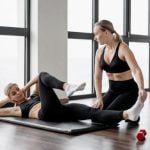Grace Fit UK is a popular fitness influencer known for her effective and challenging workout routines, including resistance band exercises that target various muscle groups. Incorporating resistance bands into your workout routine can help increase strength, flexibility, and endurance while providing a low-impact option for those looking to add variety to their training.
Resistance bands come in different levels of resistance, making it important to choose the right band for your fitness level to ensure proper form and effectiveness during exercises. Before diving into the exercises, it is crucial to start with a thorough warm-up and stretching routine to prepare your muscles for the workout ahead and prevent injury.
From lower body exercises such as squats and lunges to upper body moves targeting arms, shoulders, and back, Grace Fit UK’s resistance band workouts offer a comprehensive full-body challenge. Core-strengthening exercises also play a key role in these routines, helping improve stability and balance while engaging the abdominal muscles. To maximize results, combining resistance band exercises with cardio can create a well-rounded workout that boosts cardiovascular health alongside strength training.
Choosing the Right Resistance Band for Your Fitness Level
Resistance bands come in a variety of resistance levels, colors, and sizes, making it important to choose the right one based on your fitness level and workout goals. Grace Fit UK offers a range of resistance bands that cater to beginners, intermediate, and advanced users.
For beginners or individuals recovering from injuries, a light resistance band is recommended to start with. These bands provide less tension and are ideal for those who are new to strength training or need to work on their form.
Intermediate users may opt for a medium resistance band which offers moderate tension for individuals looking to challenge themselves further. These bands are suitable for those who have been incorporating resistance band exercises into their routine and are ready to progress to the next level. Advanced users can choose heavy or extra-heavy resistance bands that provide the highest level of tension, perfect for seasoned athletes or individuals looking to build muscle mass and strength.
It is essential to consider your current strength and fitness level when selecting a resistance band. Starting with a band that is too challenging can lead to poor form and potential injury, while using one that is too light may not provide enough stimulus for muscle growth. By choosing the right resistance band based on your individual needs, you can effectively progress in your workouts and see improvements in strength and endurance over time.
When selecting a resistance band, also take into account the exercises you plan to perform as different movements may require varying levels of resistance. For example, upper body exercises like bicep curls or shoulder presses may require a lighter band compared to lower body exercises such as squats or hip thrusts. Be sure to test out different bands and adjust accordingly based on your comfort level and ability to complete each exercise with proper form.
| Fitness Level | Recommended Resistance Band |
|---|---|
| Beginner | Light Resistance Band |
| Intermediate | Medium Resistance Band |
| Advanced | Heavy/Extra-Heavy Resistance Band |
Warm-Up and Stretching Routine Before Starting the Exercises
Grace Fit UK is known for promoting the use of resistance bands in her workouts, which can help increase muscle strength and endurance while also improving flexibility. Before diving into the various resistance band exercises, it is crucial to start with a proper warm-up and stretching routine. This helps prepare your muscles for the upcoming workout, reduces the risk of injury, and enhances overall performance.
Here are some essential warm-up exercises and stretches to incorporate into your routine before using resistance bands:
- Start with a few minutes of light cardio, such as jogging in place or jumping jacks, to increase heart rate and blood flow to the muscles.
- Perform dynamic stretches like leg swings, arm circles, and hip rotations to loosen up joints and enhance flexibility.
- Focus on stretching major muscle groups involved in resistance band exercises, such as hamstrings, quadriceps, glutes, shoulders, and chest.
Incorporating a proper warm-up not only prepares your body for the workout ahead but also helps mentally transition into exercise mode. By taking the time to properly warm up and stretch, you set yourself up for a more effective and safe workout with grace fit uk resistance band exercises. Remember that listening to your body and gradually increasing intensity is key in preventing injury during your fitness journey.
Lower Body Exercises Using Resistance Bands, Including Squats and Lunges
Grace Fit UK is known for popularizing resistance band workouts, offering a convenient and effective way to build strength and tone muscles. Lower body exercises using resistance bands, such as squats and lunges, are particularly beneficial for targeting the glutes, hamstrings, and quads. Incorporating these exercises into your fitness routine can help improve overall lower body strength and stability.
When performing lower body exercises with resistance bands, it is important to choose the right band for your fitness level. Resistance bands come in different levels of resistance, ranging from light to heavy. Beginners may want to start with a lighter band to focus on mastering proper form before progressing to a higher level of resistance. As you build strength and endurance, you can gradually increase the intensity by switching to a heavier band.
To get the most out of your lower body workout with resistance bands, consider incorporating a variety of exercises that target different muscle groups. Here are some effective lower body exercises using resistance bands:
- Squats: Place the resistance band around your thighs or just above your knees, stand with feet hip-width apart, and push your hips back as you lower into a squat position.
- Lunges: Step one foot forward or backward while keeping tension on the resistance band, bend both knees to lower your body towards the ground.
- Glute bridges: Lie on your back with knees bent and feet hip-width apart, place the resistance band just above your knees, then lift hips off the ground while squeezing your glutes at the top.
Upper Body Exercises Targeting Arms, Shoulders, and Back
Resistance bands are a versatile and effective tool for targeting the upper body muscles, including the arms, shoulders, and back. Incorporating resistance band exercises into your workout routine can help build strength, improve muscle tone, and increase flexibility. Grace Fit UK has popularized using resistance bands in her workouts, showcasing how they can be used to achieve impressive results.
Arms
One of the most common upper body exercises using resistance bands is the bicep curl. To perform this exercise, stand on the middle of the resistance band with feet hip-width apart, holding one end of the band in each hand. With palms facing forward, curl your hands towards your shoulders while keeping your elbows close to your body.
Slowly lower back down and repeat for a set number of repetitions. This exercise targets the biceps and can help sculpt strong and toned arms.
Shoulders
For shoulder exercises, try lateral raises with resistance bands. Begin by stepping on one end of the band with one foot and holding the other end in the opposite hand at your side. Keeping a slight bend in your elbow, raise your arm out to the side until it reaches shoulder height. Slowly lower back down and repeat on both sides. This exercise targets the deltoid muscles in your shoulders and can help improve overall shoulder strength.
Back
To target your back muscles with resistance bands, try bent-over rows. Begin by stepping on the middle of the band with both feet while holding one end in each hand. Hinge at the hips to bring your torso parallel to the floor, keeping a slight bend in your knees.
Pull both elbows up towards the ceiling while squeezing your shoulder blades together. Lower back down with control and repeat for a set number of reps. This exercise helps strengthen the muscles in your upper back, promoting better posture and overall back health when done correctly.
Incorporating these upper body exercises targeting arms, shoulders, and back into your routine can help you achieve a well-rounded workout that targets multiple muscle groups effectively. Remember to focus on proper form and technique to maximize results while minimizing injury risk when performing these resistance band exercises inspired by Grace Fit UK’s fitness routines.
Core-Strengthening Exercises With Resistance Bands
Plank With Resistance Band Row
One of the most effective ways to target your core muscles using resistance bands is by incorporating a plank with a row motion. Start by placing the resistance band around your wrists and get into a high plank position, ensuring that your body forms a straight line from head to heels.
Engage your core and keep your hips stable as you alternate pulling each arm up towards your ribcage in a rowing motion. This exercise not only targets your abdominal muscles but also engages your back and shoulders, providing a full upper body workout.
Dead Bug With Resistance Band Pulldown
The dead bug exercise is another fantastic core-strengthening move that can be intensified by adding resistance bands. Lie on your back with the resistance band secured around a sturdy object above you, such as a door handle or bar. Extend your arms towards the anchor point while keeping your legs in tabletop position.
Slowly lower one leg towards the floor while simultaneously pulling down on the resistance band with the opposite arm. Alternate sides to work both sides of your core evenly, focusing on maintaining stability and control throughout the movement.
Russian Twists With Resistance Bands
Russian twists are a classic core exercise that can be made more challenging by incorporating resistance bands. Sit on the floor with your knees bent and feet lifted off the ground, holding onto the ends of the resistance band with both hands.
Lean back slightly to engage your abs and twist your torso from side to side, bringing the resistance band across your body as you rotate. This dynamic movement targets not only your obliques but also engages the entire core, helping improve rotational strength and stability.
By incorporating these core-strengthening exercises with resistance bands into your fitness routine, you can effectively target and strengthen all areas of your midsection while improving overall stability and balance. Remember to focus on proper form and technique to maximize results while minimizing any risk of injury.
Combining Resistance Band Exercises With Cardio for a Full-Body Workout
Resistance band exercises are a versatile and effective way to incorporate strength training into your fitness routine, and when combined with cardio, they can provide a full-body workout that targets multiple muscle groups. Grace Fit UK, known for her popular resistance band workouts, emphasizes the importance of incorporating both resistance training and cardiovascular exercise for overall fitness and health.
When combining resistance band exercises with cardio, it is important to choose exercises that complement each other and work different muscle groups. For example, you can perform a circuit of resistance band squats or lunges followed by a set of high-intensity cardio such as jumping jacks or burpees. This combination not only provides strength training benefits but also helps elevate your heart rate for an added cardiovascular challenge.
Incorporating cardio into your resistance band workout can help improve endurance, burn more calories, and enhance overall fitness levels. Grace Fit UK often recommends interval training, where you alternate between periods of high-intensity exercise and lower-intensity recovery periods. This method not only keeps the workout interesting but also allows you to push yourself harder during the high-intensity intervals while still getting the benefits of resistance band exercises.
By combining resistance band exercises with cardio, you can create a dynamic full-body workout that targets various muscle groups while improving cardiovascular health. Whether you are looking to increase strength, build endurance, or simply switch up your routine, incorporating both types of exercise can help you achieve your fitness goals effectively. Grace Fit UK’s variety of resistance band workouts offer a range of exercises to keep your workouts challenging and engaging.
Cool-Down and Stretching Routine to Prevent Injury and Promote Recovery
After completing a challenging resistance band workout inspired by Grace Fit UK, it is important to incorporate a cool-down and stretching routine to prevent injuries and promote muscle recovery. Cooling down allows your heart rate to gradually return to normal, while stretching helps improve flexibility and reduce muscle soreness. These post-workout rituals are essential for maintaining overall fitness and preventing potential injuries.
One effective way to cool down after a resistance band workout is to walk briskly or jog lightly for about 5-10 minutes. This gentle cardio activity helps bring down your heart rate gradually and aids in removing waste products from your muscles. Following this, you can transition into static stretches that target the major muscle groups worked during the exercise session. Holding each stretch for 15-30 seconds can help improve flexibility and prevent stiffness.
Incorporating dynamic stretches into your cool-down routine can also be beneficial in promoting recovery and preventing injury. Dynamic stretching involves moving your muscles through a full range of motion in a controlled manner, which helps increase blood flow and warm up the body even further. By combining static and dynamic stretches in your post-workout routine, you can enhance flexibility, reduce muscle tightness, and improve overall performance in future workouts featuring Grace Fit UK resistance band exercises.
Tips for Proper Form and Technique When Using Resistance Bands
Resistance band exercises can be highly effective in building strength, enhancing flexibility, and improving overall fitness. However, it is crucial to maintain proper form and technique to maximize the benefits of these workouts and prevent injuries. Here are some essential tips to keep in mind when using resistance bands:
First and foremost, ensure that the resistance band is securely anchored before starting any exercise. Whether you are wrapping it around your feet, attaching it to a door anchor, or holding it under your feet, make sure the band is stable and will not snap back unexpectedly during the workout.
Secondly, focus on maintaining proper posture throughout each exercise. This includes keeping your back straight, shoulders relaxed, and core engaged. Avoid slouching or arching your back excessively, as this can lead to strain on your muscles and joints. By maintaining good posture, you target the intended muscle groups more effectively.
Lastly, control the movement of the resistance band at all times. Avoid using momentum or swinging motions to complete an exercise as this can reduce the effectiveness of the workout and increase the risk of injury. Instead, move slowly and deliberately through each repetition, ensuring that you are feeling the targeted muscles engage with each movement.
| Tips for Proper Form | Technique Tips |
|---|---|
| Securely anchor resistance bands | Maintain proper posture |
| Focus on stability | Control movement throughout |
Advanced Resistance Band Exercises for Those Looking to Challenge Themselves
As you progress in your fitness journey and become more comfortable with using resistance bands, you may be looking to challenge yourself further. Grace Fit UK offers a variety of advanced resistance band exercises that can take your workout to the next level. These exercises target various muscle groups and provide an intense burn that will push you to new limits.
One advanced resistance band exercise to consider is the resistance band pull-up. This exercise not only strengthens your back muscles but also engages your core for stability. Another challenging move is the single-leg Romanian deadlift with a resistance band, which hones in on your balance and targets your hamstrings and glutes effectively. Additionally, incorporating resistance bands into plyometric exercises like jump squats or mountain climbers can ramp up the intensity of your workout and boost your cardiovascular fitness.
Incorporating these advanced resistance band exercises into your routine can help prevent plateaus in your fitness progress and keep things exciting and engaging. Remember to always focus on proper form and technique to maximize the benefits of each exercise while minimizing the risk of injury. With dedication and consistency, you can continue to challenge yourself, improve your strength and endurance, and reach new heights in your fitness journey with Grace Fit UK resistance band exercises.
Frequently Asked Questions
Can You Lose Weight With Just Resistance Bands?
Losing weight with just resistance bands is possible, but it’s important to combine this form of exercise with a balanced diet and other types of workouts for best results. Resistance bands can help build muscle mass, increase strength, and improve metabolism which can aid in weight loss.
Do Resistance Bands Actually Work?
Resistance bands are effective tools for strength training because they provide resistance throughout the entire movement, engaging muscles in both the concentric and eccentric phases. They are versatile, portable, and suitable for all fitness levels. Consistent use of resistance bands can result in improved muscle tone, strength, and endurance.
How Many Times a Week Should You Do Resistance Band Training?
The frequency of resistance band training depends on individual fitness goals, overall health condition, and recovery capacity. Generally, incorporating resistance band exercises 2-3 times a week can be beneficial for muscle growth and strength gains without risking overtraining. It’s essential to allow adequate rest between sessions to prevent injury and promote muscle recovery.

Passionate about providing useful information to anyone with an interest in the field of Personal Training, I strive to pass on to our readers quality information and to answer any questions about Personal Trainers, the work they do and how to become one.





